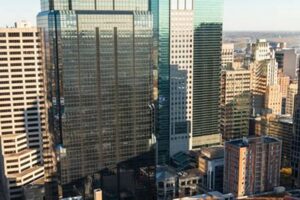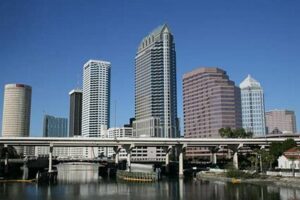City skyscrapers are tall, steel-framed buildings that house a variety of commercial, residential, and institutional uses. They are typically over 150 meters (492 feet) tall and have more than 50 floors. Skyscrapers are often associated with large cities and are often seen as symbols of economic power and prosperity.
. The world’s first skyscraper was the Home Insurance Building in Chicago, Illinois, which was completed in 1884 and had 10 stories. Since then, skyscrapers have been built all over the world, with the tallest currently being the Burj Khalifa in Dubai, United Arab Emirates, which stands at 828 meters (2,717 feet) tall. Skyscrapers are often designed with a variety of features to make them more efficient and sustainable and may have features such as green roofs, solar panels, and wind turbines.
Skyscrapers offer a number of advantages over other types of buildings. They can accommodate a large number of people and businesses in a relatively small area, which can help to reduce traffic congestion and pollution. Skyscrapers can also be designed to be very energy-efficient, which can help to reduce operating costs. In addition, skyscrapers can be iconic landmarks that can help to define a city’s skyline.
However, skyscrapers also have some disadvantages. They can be expensive to build and maintain, and they can be difficult to evacuate in the event of a fire or other emergency. Additionally, skyscrapers can sometimes cast long shadows, which can block sunlight from reaching the streets below.
1. Height
The height of a skyscraper is one of its most defining features. It is what makes skyscrapers so iconic and recognizable, and it is also what allows them to accommodate a large number of people and businesses in a relatively small area.
The height of a skyscraper is determined by a number of factors, including the building’s structural design, the materials used in its construction, and the local building codes. However, the primary factor that determines a skyscraper’s height is its intended use.
For example, residential skyscrapers are typically taller than commercial skyscrapers because they need to accommodate more people. The Burj Khalifa, the tallest building in the world, is a residential skyscraper with over 160 floors. On the other hand, the Shanghai Tower, the second tallest building in the world, is a commercial skyscraper with over 120 floors.
The height of a skyscraper can have a significant impact on its design and construction. Taller skyscrapers require more robust structural systems and more advanced construction techniques. They also require more elevators and other vertical transportation systems to move people and goods throughout the building.
However, the height of a skyscraper can also provide a number of benefits. Taller skyscrapers can offer stunning views of the surrounding city and can be used to create iconic landmarks. They can also be more energy-efficient than shorter buildings because they can take advantage of natural ventilation and daylighting.
Overall, the height of a skyscraper is a key factor that determines its design, construction, and use. Taller skyscrapers can accommodate more people and businesses in a relatively small area, but they also require more robust structural systems and more advanced construction techniques.
2. Density
The high density of city skyscrapers is a key factor in their efficiency as users of land. Skyscrapers can accommodate a large number of people and businesses in a relatively small area, which can help to reduce traffic congestion and pollution. This is especially important in densely populated urban areas, where land is scarce and expensive.
For example, the Burj Khalifa in Dubai, United Arab Emirates, is the tallest building in the world and has a total floor area of over 3.3 million square feet. This allows the Burj Khalifa to house over 30,000 people and 12,000 businesses. If these people and businesses were housed in traditional low-rise buildings, they would require a much larger area of land.
The high density of city skyscrapers also makes them more energy-efficient. Skyscrapers can be designed to take advantage of natural ventilation and daylighting, which can reduce the need for artificial lighting and heating. In addition, skyscrapers can be equipped with green roofs and other sustainable features that can help to reduce their environmental impact.
Overall, the high density of city skyscrapers is a key factor in their efficiency as users of land. Skyscrapers can accommodate a large number of people and businesses in a relatively small area, which can help to reduce traffic congestion, pollution, and energy consumption.
3. Mixed-use
The mixed-use nature of city skyscrapers is a key factor in their ability to create vibrant and sustainable urban environments. By combining a variety of uses within a single building, skyscrapers can reduce the need for travel and create more walkable and livable neighborhoods.
- Increased density and efficiency: Mixed-use skyscrapers can accommodate a higher density of people and businesses than single-use buildings, making more efficient use of land and resources.
- Reduced transportation needs: By providing a variety of uses within a single building, mixed-use skyscrapers can reduce the need for travel, as residents and workers can access a variety of amenities without leaving the building.
- Enhanced social interaction: Mixed-use skyscrapers can create more vibrant and socially interactive environments by bringing together people from different backgrounds and with different needs.
- Improved sustainability: Mixed-use skyscrapers can be more sustainable than single-use buildings by reducing energy consumption and greenhouse gas emissions.
Overall, the mixed-use nature of city skyscrapers is a key factor in their ability to create vibrant, sustainable, and livable urban environments.
4. Sustainability
In the context of city skyscrapers, sustainability refers to the design and construction of skyscrapers in a way that minimizes their environmental impact and promotes the well-being of occupants and the surrounding community.
- Energy efficiency: Skyscrapers can be designed to be energy-efficient by using high-performance building materials, optimizing building orientation to maximize natural light an
d ventilation, and installing energy-efficient appliances and lighting systems. - Water conservation: Skyscrapers can incorporate water-saving features such as low-flow plumbing fixtures, rainwater harvesting systems, and drought-tolerant landscaping.
- Waste reduction: Skyscrapers can be designed to reduce waste by incorporating recycling and composting programs, and by using sustainable building materials that can be recycled or reused at the end of the building’s life.
- Indoor environmental quality: Skyscrapers can be designed to promote the health and well-being of occupants by providing access to natural light and ventilation, using low-VOC (volatile organic compound) materials, and maintaining good indoor air quality.
By incorporating sustainable features, city skyscrapers can reduce their environmental impact, improve the well-being of occupants, and contribute to the creation of more sustainable and livable cities.
5. Economic drivers
Skyscrapers are often seen as symbols of economic power and prosperity, and for good reason. They can attract businesses and investment to cities, creating jobs and boosting the local economy.
- Job creation: Skyscrapers can create jobs in a variety of fields, including construction, engineering, architecture, property management, and hospitality. The construction of a single skyscraper can create thousands of jobs, and once the building is complete, it can house thousands of workers.
- Increased tax revenue: Skyscrapers can generate significant tax revenue for cities. This revenue can be used to fund public services, such as education, transportation, and healthcare.
- Attracting businesses: Skyscrapers can attract businesses to cities by providing them with modern, efficient, and prestigious office space. Many businesses are willing to pay a premium to be located in a skyscraper, especially if it is in a desirable location.
- Increased investment: Skyscrapers can also attract investment to cities. Investors are often drawn to cities with a strong economy and a growing skyline. The presence of skyscrapers can signal that a city is a good place to invest.
Overall, skyscrapers can be a major economic driver for cities. They can create jobs, generate tax revenue, attract businesses, and increase investment. This can lead to a more prosperous and vibrant city.
6. Cultural icons
Skyscrapers are often seen as symbols of economic power and prosperity, and they can become cultural icons that define the skyline of a city. This is because skyscrapers are often associated with innovation, progress, and ambition.
- Architectural Landmarks: Skyscrapers can be architectural landmarks that attract tourists from around the world. They can also be used to promote a city’s image and identity. For example, the Burj Khalifa in Dubai is one of the most recognizable buildings in the world and has become a symbol of the city’s economic power and ambition.
- Tourist Attractions: Many skyscrapers offer observation decks or other tourist attractions that allow visitors to experience the city from a unique perspective. For example, the Empire State Building in New York City offers stunning views of the city from its observation deck.
- Cultural Significance: Skyscrapers can also have cultural significance and can be associated with a particular era or event. For example, the Chrysler Building in New York City is an Art Deco masterpiece that is considered to be one of the most iconic buildings in the world.
- Economic Impact: Skyscrapers can have a significant economic impact on a city by attracting businesses and investment. They can also create jobs and boost the local economy.
Overall, skyscrapers can become cultural icons that define the skyline of a city and symbolize its economic power and prosperity. They can be architectural landmarks, tourist attractions, and cultural symbols that attract visitors from around the world.
7. Transportation hubs
City skyscrapers are often located near major transportation hubs, such as train stations, bus stops, and airports. This is because skyscrapers house a large number of people who need to be able to get to and from work quickly and easily. By being located near transportation hubs, skyscrapers make it easy for commuters to get to work without having to spend a lot of time in traffic.
- Reduced Traffic Congestion: By being located near transportation hubs, skyscrapers help to reduce traffic congestion on the roads. This is because commuters can use public transportation or walk to work, instead of driving.
- Increased Accessibility: Being located near transportation hubs makes skyscrapers more accessible to people who do not have cars. This includes people who live in other parts of the city, as well as people who are visiting from out of town.
- Improved Air Quality: By encouraging people to use public transportation or walk to work, skyscrapers can help to improve air quality in cities. This is because fewer cars on the road means less pollution.
- Enhanced Economic Development: By making it easier for people to get to work, skyscrapers can help to boost economic development in cities. This is because businesses are more likely to locate in cities where their employees can easily get to work.
Overall, the location of skyscrapers near transportation hubs has a number of benefits for commuters, cities, and businesses. By reducing traffic congestion, increasing accessibility, improving air quality, and enhancing economic development, skyscrapers play an important role in creating more livable and sustainable cities.
City Skyscrapers
Skyscrapers are a defining feature of modern cities, and they often raise questions about their impact on the urban environment and quality of life. Here are answers to some frequently asked questions about city skyscrapers:
Question 1: Are skyscrapers safe?
Skyscrapers are designed to be safe and withstand a variety of natural disasters, including earthquakes, hurricanes, and fires. They are built with strong structural systems and advanced fire safety features to protect occupants in the event of an emergency.
Question 2: Are skyscrapers energy-efficient?
Skyscrapers can be designed to be energy-efficient by using high-performance building materials, optimizing building orientation to maximize natural light and ventilation, and installing energy-efficient appliances and lighting systems. Some skyscrapers also incorporate renewable energy sources, such as solar panels and wind turbines, to reduce their environmental impact.
Question 3: Do skyscrapers create wind tunnels?
Skyscrapers can create wind tunnels at their base, especially if they are located in a windy area. This can be a problem for pedestrians and cyclists, but it c
an be mitigated by using wind baffles or other design features to redirect the wind.
Question 4: Are skyscrapers affordable?
The cost of skyscrapers can vary depending on a number of factors, including the size, location, and design of the building. However, skyscrapers are generally more expensive to build and maintain than smaller buildings. This can make it difficult for affordable housing to be incorporated into skyscrapers.
Question 5: Are skyscrapers good for cities?
Skyscrapers can have both positive and negative impacts on cities. On the positive side, skyscrapers can create jobs, generate tax revenue, and attract businesses to cities. They can also be iconic landmarks and tourist attractions. On the negative side, skyscrapers can be expensive to build and maintain, and they can create wind tunnels and other problems for pedestrians. Overall, whether or not skyscrapers are good for cities depends on a number of factors, including the specific design and context of the building.
Question 6: What is the future of skyscrapers?
The future of skyscrapers is likely to be characterized by a focus on sustainability and innovation. Skyscrapers are becoming increasingly energy-efficient and environmentally friendly, and they are also incorporating new technologies, such as smart building systems and vertical gardens. In addition, skyscrapers are becoming more mixed-use, with a variety of residential, commercial, and public spaces. This trend is likely to continue as cities become more dense and diverse.
In conclusion, skyscrapers are complex and multifaceted structures that can have a significant impact on cities. By understanding the benefits and challenges associated with skyscrapers, we can make informed decisions about how to use them to create more sustainable, livable, and equitable cities.
Transition: To learn more about city skyscrapers, their history, and their impact on the urban environment, continue reading the main article.
Tips on City Skyscrapers
City skyscrapers are marvels of modern engineering that can have a significant impact on the urban environment. By following these tips, architects, urban planners, and developers can create skyscrapers that are sustainable, livable, and iconic.
Tip 1: Design for sustainability
Skyscrapers can be designed to be energy-efficient and environmentally friendly by using high-performance building materials, optimizing building orientation to maximize natural light and ventilation, and installing energy-efficient appliances and lighting systems. Some skyscrapers also incorporate renewable energy sources, such as solar panels and wind turbines, to reduce their environmental impact.
Tip 2: Create mixed-use spaces
Mixed-use skyscrapers combine a variety of uses, such as residential, commercial, and public spaces. This can create more vibrant and sustainable neighborhoods by reducing the need for travel and creating more opportunities for interaction between people.
Tip 3: Consider the impact on wind
Skyscrapers can create wind tunnels at their base, especially if they are located in a windy area. This can be a problem for pedestrians and cyclists. To mitigate this problem, architects can use wind baffles or other design features to redirect the wind.
Tip 4: Incorporate public spaces
Skyscrapers can incorporate public spaces, such as parks, plazas, and gardens, into their design. This can create more inviting and livable spaces for people to enjoy.
Tip 5: Design for resilience
Skyscrapers should be designed to withstand a variety of natural disasters, including earthquakes, hurricanes, and fires. This can be achieved by using strong structural systems and advanced fire safety features.
Tip 6: Consider the views
Skyscrapers offer unique opportunities for views of the city. Architects should consider the views from different parts of the building and design accordingly.
Tip 7: Create a sense of place
Skyscrapers should be designed to create a sense of place and identity for the people who live and work in them. This can be achieved through the use of unique architectural features, public art, and other design elements.
Summary of key takeaways or benefits
By following these tips, architects, urban planners, and developers can create city skyscrapers that are sustainable, livable, and iconic. Skyscrapers can play a vital role in creating more vibrant, sustainable, and equitable cities.
Transition to the article’s conclusion
City skyscrapers are a defining feature of modern cities, and they will continue to play an important role in the future. By following these tips, we can create skyscrapers that are sustainable, livable, and iconic.
City Skyscrapers
City skyscrapers are a dominant feature of modern skylines, serving as symbols of economic power and architectural innovation. Throughout this article, we have explored various aspects of city skyscrapers, including their height, density, mixed-use nature, sustainability, economic impact, cultural significance, and importance as transportation hubs.
While skyscrapers offer numerous benefits, such as increased density, energy efficiency, and job creation, they also present challenges related to wind tunnels, affordability, and potential environmental impact. To mitigate these challenges and maximize the benefits of skyscrapers, architects, urban planners, and developers must prioritize sustainability, mixed-use design, resilience, and the creation of public spaces.
As cities continue to grow and evolve, city skyscrapers will undoubtedly play a crucial role in shaping the urban landscape. By embracing innovative design principles and sustainable practices, we can ensure that skyscrapers contribute positively to the livability, sustainability, and overall vitality of our cities.







